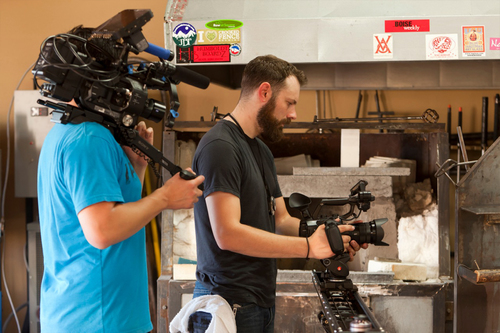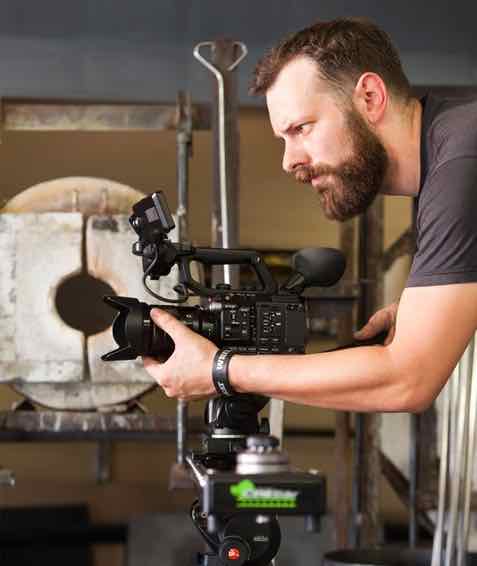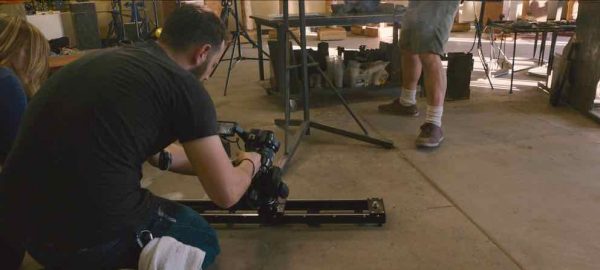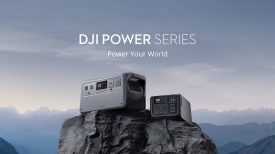The Sony FS5, expected to ship in early December, looks like an ideal camera on paper for many real world shooters; but so far only a select few have had the chance to use it and publish the results. Rob Scribner is one of the lucky ones.
Rob was asked by Sony Professional Solutions Americas to make a documentary-style film for them. The result was Zion, a short about a glass blower in Boise, Idaho. It was shot entirely on the FS5 and an FS7 was used to film behind the scenes.
Rob posted his piece about a month ago, but new BTS footage gives an insight into FS5 and how the short piece was filmed. Rob’s written up his experiences with the camera on his blog, and we’re reposting some edited highlights here with his permission.
Project background:
To be honest, [Sony] really didn’t explain much of other than we want you to make a short film, a passion project, tell a story of something that you want to do… Across the street from my studio a new glass blowing studio just opened their doors… and the rest was history.
ND Filters:
One of my favorite features in the camera [is] the variable ND filter. I used this quite a bit during the shooting of Zion because of the intensity of the glass furnace and some of the other ovens would either over expose or under expose the shot. It was so great being able to make my own presets of the exact ND filter combination without having to sacrifice my exposure, shutter or gain. I could just flick a switch, turn the ND filter knob and my shot was just the way I wanted it.
Codec:
The main 4K codec is XAVC-L GOP. It’s not as good as XAVC-I because it’s not just I-frames but instead using Group Of Pictures for its compression by analyzing what has changed from frame to frame, based on the I-frame. I have had many people ask what did you think of it…well, it’s not bad. I found it pretty easy to use and with enough work in post editors will be able to get it to match up quite nice with the FS7 XAVC-I in Cine EI Slog3.
Proxy files:
Now that 4K filming is becoming more common, depending on your editing system you might have some problems editing those massive 4K files. Having a camera that auto creates h.264 proxy files, saves a bunch of time transcoding files for offline editing. Plus you can login into an FTP system and once the camera is linked to the internet either through WiFi or using your smartphone, you can send those proxy files to your FTP, ready for your editor to start an assembly edit. It’s a huge time saver in so many ways. Simply amazing!
Slow motion:
We all love slow motion but there’s the issue of how do you switch modes in order to use it. Sony have overhauled the menu system on the FS5, and it allows you to switch between codecs, resolutions and frame rates very fast… much faster than the FS7. Once I set my codec, if I wanted HFR, I would hit the S&Q button. Seriously, it’s that fast and easy; again, a super time saver in the middle of shoot.
Size and weight
At the end of the day, here’s what really got me: the form factor. This camera is so small and light… it almost seems not right. The fact that it is set up just like the FS7 and so small, it’s just perfect. The problem I have with the FS7 for run and gun documentary is how heavy the camera gets when you add a big lens, extension unit, V-Mount battery, Odyssey 7Q+ with batteries, matte box, and rail system with a follow focus on it. It’s great to have a stripped down version of the camera that is extremely lightweight, operates the same way, and even if I added all those FS7 extras… it’s still much lighter and balanced. I also have found that hand holding the FS5 was nice and stable; I can move so fast with it.
Using it on set:
When filming Zion, I knew that I wanted to add movement to my shots as a metaphor for what it’s like to work with glass: you have to keep moving, shaping it, in order to get the look you want. If you look at the footage I shot, there is very little shake in the camera; working with the FS7 on a slider and how heavy it can be can make it very difficult to move without getting a little bit of camera shake. The FS5 is so well balanced and light, I was able to move the camera left and right, back and forward, even pan and tilt the camera while focusing on the slider as if I had three people working on a dolly system. Shots like this require skill but you have to rely on your tools to pull it off… I found the FS5 is perfectly setup up for lone operators.
Handheld:
Shooting handheld on the FS5 is so easy. It really comes down to how well the body has been designed and balanced. Sony has also taken a really neat approach to how the side grip feels and operates. When connecting, it looks just like a lens mount but what it allows is for the user to press a button and very, very quickly adjust the clocking of the side grip.
Final Thoughts:
Cameras come and go, they are merely tools to help your story. At the moment I look for a camera that can compete with others on the big screen, at a cost that makes owning rather than renting worthwhile. I have made the leap and invested in the FS7 which has been amazing until now. But long story short I am getting an FS5 and I am keeping my FS7. The two together will help me tell stories the way I see them in my head. Soon in my career, I hope to be stepping up into a new tier of cameras and the FS7 and FS5 are going to help me get there.
For more information about Rob head over to his website Skytower Films.








